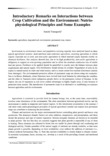Introductory Remarks on Interactions between Crop Cultivation and the Environment: Nutrio-physiological Principles and Some Examples
JIRCAS international symposium series
| ISSN | 13406108 |
|---|---|
| 書誌レコードID(総合目録DB) | AA1100908X |

本文フルテキスト
intlsymp-13_15-24.pdf707.93 KB
Involvement in environment issues and population-carrying capacity were analyzed based on three typical agricultural systems: slash-and-burn semi-sedentary agriculture, recycling agriculture in which organic materials are re-used, and non-cyclic agriculture in which nutrient supply depends chiefly on chemical fertilizers. Our analysis showed that, due to its high productivity, non-cyclic agriculture is obligatory to support an ever-growing population and to offset the resultant continuous loss of arable land per person. Fertilizers to be applied should be quantified to exactly meet the balance between plant requirements and natural supply. Over-fertilization should always be avoided. Degradation of soils in the tropics is caused mainly by water and wind erosion, and to a lesser extent from nutrient disturbance (mainly from shortages). The environmental-protective effects of permanent crops are shown using two examples. One is in Erimo, Hokkaido, where fishermen have revived their local fisheries by reforesting the coastline, and the other in Tanzania where indigenous people thrive on the permanent culture of bananas. In the tropics, the use of vegetation as soil cover confers advantages in highly fragile areas, if only because of protection from erosion. The introduction of permanent crops is an alternative to establishing co-existence between agriculture and the environment.
| 作成者 | Junichi Yamaguchi |
|---|---|
| 著者キーワード | agriculture degraded soil environment permanent crop tropics |
| 公開者 | Japan International Research Center for Agricultural Sciences |
| オンライン掲載日 | |
| 号 | 13 |
| 開始ページ | 15 |
| 終了ページ | 24 |
| 言語 | eng |
